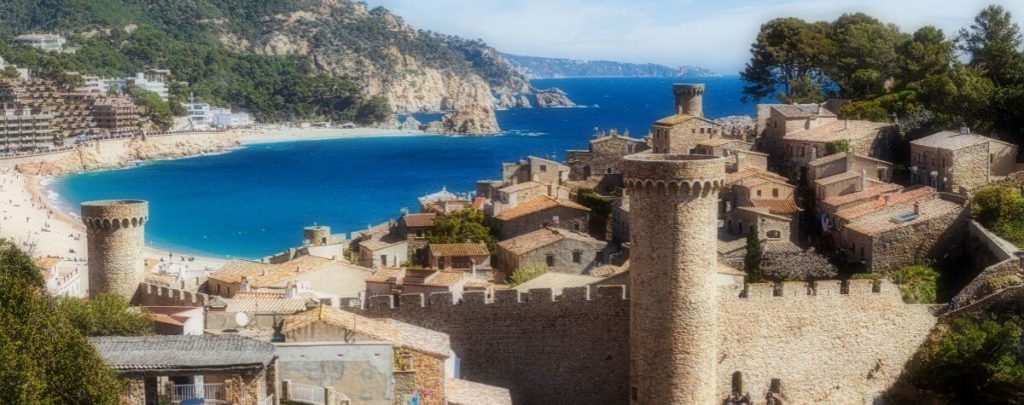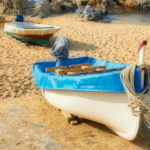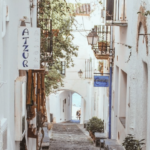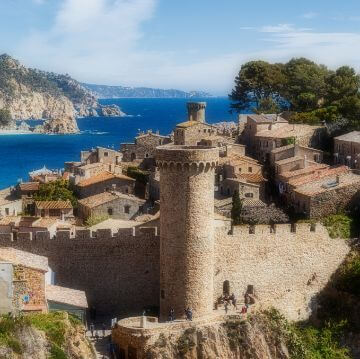
Ultimate guide to Tossa de Mar (Catalonia)
WHAT TO DO DURING YOUR TOSSA DE MAR HOLIDAYS
Tossa de Mar is one of the most iconic seaside towns of the Costa Brava (Spain). Located just over one hour from Girona and also just over an hour from Barcelona, its easy access by car (a bit more complex by public transportation) and its scenic beaches make it a must-see when spending your holidays in the area. It has the perfect combination of medieval heritage and Mediterranean landscapes, plus a great restaurant offer and cool little shops. We’ve prepared for you a complete guide so you don’t miss anything that this beautiful town has to offer.
Explore the Castle in Tossa de Mar
1
Medieval Walls and Towers
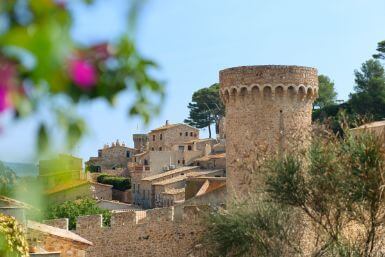
Technically, Tossa de Mar doesn't have a castle, even if it looks like that from the distance. Tossa de Mar has a fortified medieval town, the only one by the sea in the entire Catalonia. My favorite way to visit it is walking up the slope that starts by the Platja Gran beach and ascends making an S to the Torre de Joanas, its most impressive tower. A gate has been opened into the wall, so visitors can access the walled enclosure from there. A bit further, just before reaching the Villa Vella restaurant, you'll find some steps excavated on the rock that lead you to a path that takes to the Tower.
If instead you continue up the road, you’ll soon find the statue to Ava Gardner, who stayed in Tossa when she was filming Pandora and the Flying Dutchman (her affair with a local bullfighter costed her the divorce from Frank Sinatra). The sculpture is located by a vantage point overlooking the bay. From there you can decide if you want to continue uphill to the ruins of Sant Vicens and further towards the lighthouse, or if you prefer to descend into the medieval old town.
There’s three more watch towers left worth seeing: two in the old town (the Codolar Tower overlooking the beach and the Clock Tower by the lower entrance to the walled enclosure), and the Torre dels Moros or Can Magi, disconnected from the wall and located further inland.
2
Ruins of Sant Vicens church
At the top of the hill you’ll find the ruins of the original church of Saint Vincent (Sant Vicens, in Catalan). Its Gothic structure dates back from the 1400’s, but there isn’t much left. The church stopped being used as the town parish church in the 1700’s, when a new one was built downhill. And a century later, during the Napoleon Wars, the French used the building to store explosive and they blew it up accidentally. Then the locals took some of its blocks of stone away to build their own homes in the village.
So right now you can see the structure of the apse, nicely framed by a pointed Gothic arch, and covered by a semicircular dome with a keystone that represents Saint Vicent. There’s also one side of the transept that used to be a chapel dedicated to the 4 Evangelists (in one capital you can make out the carving of an eagle, symbol of Saint John). There’s also part of the nave walls, but no other areas covered by a ceiling.
This church is accessible, and often during the Summer they celebrate concerts and cultural events there. Nearby you can see some canons from the 1600’s. When the church was destroyed in the explosion of the Napoleonic Wars, they fell off from a nearby defense tower to the sea, and they were recovered on a submarine expedition in 1966. A bit further up the hill you can also visit the Tossa de Mar Lighthouse with its small museum, where the “real” castle of Tossa used to stand.
3
Tossa de Mar Old Town
From there, the D. Ygnacio Mele street takes you further down, to the Plaça del Pintor J Vilallonga, that was the main square of the stronghold. It acted as a sort of entrance hall, as the only gate of the medieval wall was there, protected by a tower where in the 1400’s was located the only public clock of the village. Right outside stands the wayside cross that marked the limit of the municipality and welcomed the travelers.
4
Municipal Museum of Tossa
The municipal museum is located in a Gothic mansion that was the headquarters of the Batlle, that ruled the town on behalf of its feudal lords – the Abbots of the Ripoll Monastery. In the early 1900’s and specially at the beginning of the 1930’s Tossa de Mar (Spain) attracted many European artists, many of them German Jewish running away from the first anti-Semitic laws that were already being passed.
Right before the Spanish Civil War broke out, in 1935 some local intellectuals decided to create a local museum to preserve the local art and archaeological remains. You can see there paintings by Marc Chagall, André Masson, Olga Sacharov as well as some Catalan artists. The museum also keeps sculptures and a mosaic found in the nearby Roman Vila dels Amatllers.
The Beaches in Tossa de Mar
5
Platja Gran
The Platja Gran is the largest beach in Tossa de Mar. Actually, its name says that: Platja Gran means Large Beach in Catalan. It’s also the most iconic and photographed, since the stronghold of the Old Tossa de Mar towers over one side of this natural bay. It is 354 m / 1161 ft long, with room for beach goers as well as for small fishing boats. The catamaran services depart from here, as well.
The sand of this beach is quite thick, which can be a bit uncomfortable if you aren’t used to it. The temperature of the water is usually coolish – just like in the rest of the Costa Brava. Once you enter the water, it goes deep quite quickly – so if you are visiting with young kids that can’t swim much, keep an eye on them at all times.
6
Platja de la Mar Menuda
The Platja de la Mar Menuda is a smaller beach, the “Beach of the Small Sea”: 163.7m / 537 ft. It is located past the end of Platja Gran, opposite to the medieval wall, and reachable via Carrer de Sant Ramon de Penyafort and Avinguda de la Mar Menuda. It is a quieter beach, often preferred by families (even if the water gets quickly deep, too). In the further end there’s a small rocky cove known as the “Banyera de les Dones” (Women’s Bathtub), that is shallower and it’s often used by scuba diving schools to enter the water from the beach.
7
Platja d'Es Codolar
This last beach is located in the back of the Old Town, and because it’s more hidden and harder to get to (you can’t drive there, and you need to descend a 50-step staircase to reach it), it’s usually less crowded than the others. But it’s also the smallest: only 24.5m / 80 ft wide. This is where the fishermen boats used to moor, and you can still see small fishing boats there.
Visiting the rest of the village
8
Shopping street
These streets are mostly pedestrian, and because they aren’t very wide, they stay shadier and fresher than the beach promenade. Here you’ll find lovely clothing stores, quirky souvenir shops, gelato parlors, and some cafes and restaurants that open also to the promenade.
9
Roman Vila dels Amatllers
This archaeological site was discovered in 1914, and it’s considered one of the most notable Roman sites of the Tarraco Province (the Northern half of Spain). From 1 BC to the 400’s, it was a superb vila decorated with impressive mosaics, a fountain and a pool. Their wealth came from wine making, but also from the production of olive oil, salted fish and cereals.
The Roman vila is located inland, between the Can Magi Watch Tower and the local cemetery. There’s parking nearby. The access is free of charge, and it’s an outdoors site. However, it’s often closed for excavation works or due to the pandemic: check before planning a visit.
10
Churches
Tossa de Mar in Spain doesn’t feature big cathedrals, but it does have some cute small churches that are worth checking out:
- Capella dels Dolors (or dels Socors). It’s the easiest to find, as it’s on Carrer del Socors – the shopping street, which bifurcates around it. It’s a tiny whitewashed building, built in 1593 by a sailor in honor of Our Lady of Help, for having survived a wreck. However, the current structure is the result of a refurbishment from 1720.
- Esglesia de Sant Vicens. Located inland, and reachable from Carrer dels Socors via Carrer de Sant Pere, it is the parish church that substituted the one on top of the hill when the population started moving outside of the walled enclosure. It is a nice baroque building with a simple façade topped with a sculpture of Saint Vicent. The inside consists of one nave and side chapels, covered with a painted dome ceiling. It features several baroque retables, a sculpture of Saint Sebastian (said to have protected the town from the plague) and a medieval baptismal font.
- Chapel of the Hospital de Sant Miquel. In 1773 a wealthy local founded a hospital for the poor. The complex included 2-storey hospital facilities, a cloister and a baroque chapel dedicated to Saint Michael. The hospital was a convent and a school in the 1900’s until it became a municipal facility that houses the local library, conference rooms and other services for the community.
More things to do in Tossa de Mar
8
Fun activities to do in Tossa
- Scuba Diving. Dreaming of seeing the underwater world? Tossa is a popular scuba diving destination, and many companies organize outings even for first-timers. See the local sea life: octopuses, crabs, morays and a variety of Mediterranean fish.
- Kayak. How cool can it be to reach small coves that can’t be accessed from the road, see impressive rock cliffs from the bottom of them, and explore sea caves that the waves have carved out throughout the centuries? You can do that with an expert professional that will keep you safe and create a great adventure for you.
- Go on a boat ride. DofiJet runs daily catamaran rides connecting Tossa de Mar with Lloret, Blanes and Calella de la Costa. Fondo Cristal organizes daily boat outings taking you to iconic Costa Brava caves and marine caves only reacheable from the sea. Bluesail Costa Brava offers also boat and catamaran daily outings, as well as private boat rentals.
- Hike the Cami de Ronda. Cami de Ronda is a hiking path that goes along the entire Catalan coast. Its technical name is GR-92, and it is marked with two color traits, one red and one white. Check the routes: South towards Lloret de Mar | North towards Sant Feliu de Guixols.
9
Day Trips around Tossa de Mar
If you have a rental car or your own, there’s many places you can visit for the day:
- Girona. Approximately 1 hour drive. Lovely medieval town with Jewish heritage sites, and Game of Thrones filming locations.
- Dali Museum of Figueres. Approximately 1.5 hours drive.
- Archaeological sites. The Roman and Greek ruins in Empuries (1hr 15min drive), and Iberian ruins in Ullastret (1 hour drive) are some of the most important in Catalonia.
- Other seaside villages in Costa Brava. Palamos, l’Escala, Calella de Palafrugell, Cadaques…
- Medieval villages of l’Emporda county. Pals, Peratallada, Sant Martí d’Empuries, Monells, Pubol…
- Water parks. A cool plan for families as well as young adults.
- Botanical gardens. The mesmerizing greenery of Santa Clotilde in Lloret de Mar, the Mediterranean feel of Cap Roig in Calella de Palafrugell, the scenic Marimurtra in Blanes, and the cacti garden of Pinya de Rosa, also in Blanes.
Our favorite Tossa de Mar hotels
Tossa de Mar best restaurants
- Bahia de Tossa. For authentic Tossa de Mar food and specialties such as cimitomba.
- La Cuina de Can Simon. For fine dinning (1 Michelin star).
- Can Tarradas. For the best seafood and paella.
- Sotavent. For great tapas.
- Tom’s Steakhouse. For meat eaters.
Getting to Tossa de Mar from Barcelona
- By road. There’s two different ways to get to Tossa de Mar from Barcelona by road. The fastest way is to take the AP7 highway to Maçanet de la Selva, then the C-35 to Llagostera, from where you take the GI681 to Tossa de Mar. It takes around 1 hour and 15 minutes, and the road goes through the countryside. Alternatively you can take the C-32 to Blanes, then the GI-600 to Tossa. It typically takes around 10 minutes longer than the other option, but you get sea views most of the way. Please note that unless your hotel has parking, finding a place to park in Tossa de Mar isn’t easy, and you’ll end up having to pay a parking lot.
- By bus. The buses from Barcelona to Tossa de Mar (Girona, Spain) depart from Estacio del Nord (near Arc de Triomf) and run daily, several times a day. The ride takes approximately 1.5 hours, depending on traffic and the number of stops. You can check the schedule here.
- By train. Unfortunately there’s no train station in Tossa. Your options are either taking the high speed train or the regional train to Girona, then bus to Lloret, then take another bus to Tossa de Mar. Or take the R1 train to Blanes, then walk 10 minutes to catch a bus to Lloret, and then another bus to Tossa. Way too much trouble!
- Private tour. You only have one day to visit Tossa de Mar? Spare yourself all of the logistics and let a professional plan it for you. Our private tours to Tossa de Mar from Barcelona take 6 to 8 hours and you’ll feel like a VIP vacationing in the Costa Brava (Spain)
RESEARCHING FOR A TRIP IS TIME-CONSUMING…
Need more inspiration?
Our 100% FREE Barcelona Collection will give you everything you need to organize the trip of your lifetime to Barcelona.
BEST INSIDER TIPS FROM THE PROS!


